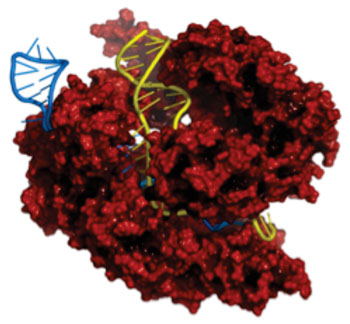Modifications Should Increase the Usefulness of CRISPR-Cas9 Gene Editing
By LabMedica International staff writers
Posted on 15 Jul 2015
A recent paper described a procedure to modify the CRISPR-Cas9 class of DNA editing nucleases to give them a wider range of usefulness and simultaneously reduce the number of off-target mutations that could be generated.Posted on 15 Jul 2015
CRISPRs (clustered regularly interspaced short palindromic repeats) are segments of prokaryotic DNA containing short repetitions of base sequences. Each repetition is followed by short segments of "spacer DNA" from previous exposures to a bacterial virus or plasmid. CRISPRs are found in approximately 40% of sequenced bacteria genomes and 90% of sequenced archaea. CRISPRs are often associated with cas genes that code for proteins related to CRISPRs. The CRISPR/Cas complex comprises a prokaryotic immune system that confers resistance to foreign genetic elements such as plasmids and phages and provides a form of acquired immunity.

Image: CRISPR-Cas9 gene-editing complex from Streptococcus pyogenes (Photo courtesy of Harvard Medical School).
Since 2013, the CRISPR/Cas system has been used in research for gene editing (adding, disrupting, or changing the sequence of specific genes) and gene regulation. By delivering the Cas9 protein and appropriate guide RNAs into a cell, the organism's genome can be cut at any desired location. However, the range of sequences that Cas9 can recognize is constrained by the need for a specific protospacer adjacent motif (PAM). As a result, it can often be difficult to target double-stranded breaks (DSBs) with the precision that is necessary for various genome-editing applications.
Investigators at the Harvard Medical School (Boston, MA, USA) reported in the June 22, 2015, online edition of the journal Nature that they had developed a technique to modified the commonly used Streptococcus pyogenes Cas9 (SpCas9) so it can recognize alternative PAM sequences using structural information, bacterial selection-based directed evolution, and combinatorial design. These altered PAM specificity variants enabled robust editing of endogenous gene sites in zebrafish and human cells not currently targetable by wild-type SpCas9, and their genome-wide specificities were comparable to wild-type SpCas9.
The investigators also found that two smaller-size Cas9 orthologues, Streptococcus thermophilus Cas9 (St1Cas9) and Staphylococcus aureus Cas9 (SaCas9), functioned efficiently in the bacterial selection systems and in human cells, suggesting that the novel engineering strategies could be extended to Cas9s from other species.
“This work just scratches the surface of the range of PAMs that can be targeted by Cas9,” said senior author Dr. J. Keith Joung, professor of pathology at Harvard Medical School. “We believe that other useful properties of the enzyme may be modified by a similar approach, allowing potential customization of many important features.”
“This additional evolved variant with increased specificity should be immediately useful to all researchers who currently use wild-type SpCas9 and should reduce the frequencies of unwanted off-target mutations,” said Dr. Joung. “Perhaps more important, our findings provide the first demonstration that the activities of SpCas9 can be altered by directed protein evolution.”
Related Links:
Harvard Medical School













